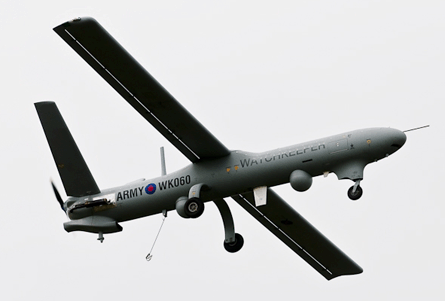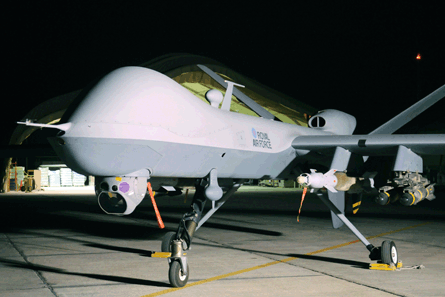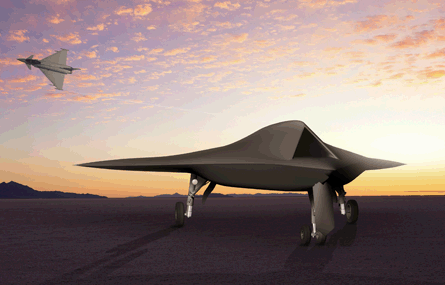Players from the UK unmanned air vehicle industry will arrive at this year's Farnborough air show with renewed optimism, following two significant steps recently made on the way towards being able to routinely fly such systems in the nation's airspace.
On 1 July, a new area of airspace was opened near the Ministry of Defence's Salisbury Plain training area in Wiltshire to support flights with the British Army's Watchkeeper 450 tactical UAV system, before its planned deployment to Afghanistan in 2011.
The end result of a lengthy period of public consultation, the newly opened sector will enable the WK450 to be flown from the MoD's Boscombe Down test facility, and from the army's nearby Upavon site in support of exercises involving British ground troops.
 |
|---|
© Thales UK |
After taking off from either location, Watchkeeper will climb to an altitude of 8,000ft (2,440m) in an existing danger area over Salisbury Plain, before heading to the south and a band of "floating airspace" which for now rises up to 16,000ft in two levels.
This will enable the UAV's twin-sensor payloads - an Elop Compass IV electro-optical/infrared camera and the Thales I-Master/Viper synthetic aperture radar/ground moving target indication sensor - to be employed from stand-off range.
"It's a small step, but a step in the right direction," says Royal Navy Lt Cdr Gerry Corbett from the Civil Aviation Authority's Directorate of Airspace Policy (DAP), which approved the airspace change proposal specifically in support of the Watchkeeper programme. "It will enable us to build evidence, and be an example of what we can do."
REPLACEMENT
To be delivered by the Thales UK/Elbit Systems joint venture U-TacS, Watchkeeper will replace the army's current use of Elbit's Hermes 450 system, which has logged more than 30,000 flight hours in support of operations in Afghanistan since 2007. Derived from the Israeli UAV, the WK450 made its first flight in UK airspace on 14 April, completing a 20min sortie from the ParcAberporth centre in west Wales.
One additional flight has been conducted since then, as Thales says "the focus in the UK is currently on environmental testing and the ground elements phase of the programme." The WK450 design has made a large number of flights in Israel since its debut sortie in April 2008, and Thales says the overall trials effort is "continuing as planned".
Gaining the ability to fly Watchkeeper over a UK military training area is a key step towards the type achieving its in-service date. This is now due in 2011, following a decision to extend the Hermes 450-based urgent operational requirement deal while army personnel prepare for a smooth transition to the new equipment.
"Watchkeeper will undergo a quite demanding trials activity before entry into service in mid-2011, and soon after will go into Afghanistan," Maj Matt Moore from headquarters, the Royal Artillery, told the Royal Air Force's UAS 2010 Symposium in Cranwell, Lincolnshire on 1 July.
In addition to using the airspace near Salisbury Plain, the army expects to first operate the WK450 in another new operating area, which will span the roughly 30km (20 miles) from ParcAberporth to the MoD's Sennybridge training area.
A formal change proposal was delivered to the DAP on 5 July, opening the way for public consultation over the proposed sector of stepped airspace, which would at its highest point enable UAV operations up to 22,500ft. As with the sector near Boscombe Down, this would only be activated when needed, and the local aviation community informed via notice to airmen.
If approved, the Welsh operating space should be open for use from around March 2011, although flights could be performed from around September under a temporary airspace restriction. Flights of the WK450 and other types, such as Selex Galileo's Falco, have been conducted on these terms from ParcAberporth for the last three years.
The CAA is generally reluctant to approve new restricted areas for remotely piloted operations, as "segregation denies airspace to other users", Corbett says.
LINE OF SIGHT
An operator in open airspace is required to maintain unaided and unbroken visual line of sight with an aircraft, and exercise visual see and avoid techniques. The UAV must also be flown within 500m horizontally and 400ft vertically of its pilot. Laid down in the CAA's CAP 722 document, these requirements are similar to those already in place for aero-modellers.
For beyond line of sight operations in non-segregated airspace, a UAV must be equipped with a detect/sense and avoid capability. Equivalence with manned platforms is a key requirement, along with transparency to air traffic control. An automatic collision avoidance system must also be installed, in case its control link becomes disrupted.
 |
|---|
© Sgt Pete Mobs/Crown Copyright |
According to Corbett, many of the objections made in response to the airspace change proposal around Boscombe Down stemmed from misunderstanding, with the UAV community facing the challenge of overturning often entrenched views about the role that such aircraft can play.
"The public perception is either: they're spying on us; they're shooting at us; or they're not safe," says Corbett. "We are trying to get rid of the phrase UAV. They are aircraft and they are piloted, albeit remotely."
His view is largely supported by Ali Green from Qinetiq's Systems Evaluation and Services unit at Boscombe Down, who led the public consultation process for the company from 2007. However, she notes that around the base - which already plays host to a large number of movements a year involving manned test aircraft, "most of the issues were to do with noise".
Indeed, the knowledge that the base will have to provide dedicated air traffic control cover for the Watchkeeper whenever it is airborne offers an actual benefit for local general aviation pilots once a 2,000ft danger area closure has been lifted following take-off, she notes.
"They will be able to share the airspace, which is a major breakthrough: civil aircraft can have access so long as they are formally separated by ATC." Providing this service will be the result of "an enormous financial undertaking" to upgrade a radar already in use at the site, she adds.
David Tilly, Qinetiq's business group manager for unmanned systems managed services, believes that Boscombe Down could in time gain permission to host activities with other types. This could enable it to become "a centre of excellence for operational testing", he believes, with air vehicles to move to the location after undergoing "first-of-type" testing at ParcAberporth. "Our vision within three to five years is to stand up a UAV capability in controlled airspace to customers," he adds.
FUNDING SECURED
Separately, the UK's Autonomous Systems Technology Related Airborne Evaluation and Assessment (Astraea) programme has now secured the £30 million ($45 million) in funding needed to launch its delayed second phase. The effort is intended to prove the sense and avoid technologies required to allow for the routine operation of UAVs in non-segregated airspace.
An initial three-year phase concluded in 2009, after researching elements such as human factors work, vehicle health management and spectrum and communications requirements. An 18-month funding gap then followed, but Astraea 2 will start shortly with work on separation assurance and autonomy, says project vice-chairman Nick Miller, of Thales UK.
Key backers for the three-year follow-on phase include the Welsh assembly government, the UK Technology Strategy Board and companies including BAE Systems, Cobham, EADS, Qinetiq, Rolls-Royce and Thales.
The aims of the Astraea project could at one time have supported suggestions to provide UAVs in support of security activities linked to the 2012 Olympic Games in London, but the funding delay means that such systems are now unlikely to play a part alongside manned assets.
Corbett says that the CAA has so far received few expressions of interest about civil operations with air vehicles weighing over 20kg (44lb). However, it has had "a large number of requests" from potential operators of small and mini air vehicles, including from the police and fire services.
However, for now at least, larger systems are likely to remain the preserve of military users, who are showing increasing interest in using their UAVs away from the operational theatre of Afghanistan.
The largest design currently flown by the UK armed forces is the General Atomics Reaper, used in Afghanistan since October 2007 by the RAF's Waddington-based 39 Sqn. By mid-June, the air force had flown more than 10,800h with its Reaper air vehicles, and released 94 weapons since armed operations began in May 2008.
The UK will soon stand up its third 24/7 intelligence, surveillance and reconnaissance orbit using the Reaper, which is capable of a roughly 16h endurance in Afghanistan carrying two Raytheon GBU-12 precision-guided bombs and four Lockheed AGM-114 Hellfire air-to-surface missiles.
"It's great for Afghanistan, but it's not necessarily great for every future conflict," Air Vice Marshal Steve Hillier, air officer commanding the RAF's 2 Group, told the UAS Symposium.
 |
|---|
© BAE Systems |
"About 70-80% of the lessons learned are highly relevant for the future," he says, citing as disadvantages the Reaper's reliance on satellite communications infrastructure, segregated airspace and the UK's inability to modify the system without US consent. The remotely piloted air system would also be vulnerable if used in an area with integrated air defences, he adds.
Controlled from the US Air Force's Creech AFB in Nevada, the UK's Reaper force includes six air vehicles and three mobile ground control stations, all deployed. Another five aircraft and four ground control stations will follow, under an expansion to the current UOR deal.
Hillier says the commitment of one 24/7 Reaper orbit for a three year period would cost £100 million and require 140 personnel, versus £300 million and 250 people to provide the same level of cover with an undisclosed manned ISR type.
Such facts could prove important in the UK's current age of "significant resource austerity," he believes.
The RAF expects to continue flying its Reapers for as long as UK forces remain in Afghanistan, but the MoD has already outlined its plans to acquire a replacement persistent intelligence, surveillance, target acquisition and reconnaissance capability to enter use around 2015-17. Current offerings could include BAE Systems' Mantis, the EADS UK-promoted X-UAS/Talarion and General Atomics' Predator C/Avenger designs.
However, Hillier says the service is unlikely to require an operational unmanned combat air vehicle this side of 2025, and sees "an enduring requirement for a human in the loop for decision making. When you get to attack, you need someone to exercise judgment," he adds.
The UK's Taranis UCAV technology demonstrator was due to be rolled out at BAE's Warton site in Lancashire on 12 July. As with previous of the company's unmanned products, flight testing is likely to take place in the secluded airspace of the Woomera test range in South Australia.
Source: Flight International























